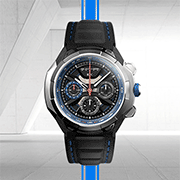Engine No. TTE P01 043 Porsche and McLaren The story of Porsche’s collaboration with McLaren International is etched deeply into Formula One history. From 1984 to 1987, the Porsche-built TAG turbo engine-powered McLaren to 25 Grand Prix victories, 18 fastest laps, and five world titles—three Drivers’ and two Constructors’—with legends like Watson, Lauda, Prost, Rosberg, and Stefan Johansson behind the wheel. Yet, this historic partnership almost never happened. In early 1981, McLaren’s Ron Dennis approached Porsche to build a turbocharged Formula One engine. True to form, the company politely declined. Dennis persisted. Later that year, he convinced Austrian Niki Lauda to return from retirement—backed by Philip Morris funding—and reignited Porsche’s interest. Dennis then proposed Porsche design the engine while McLaren covered the costs. With that, project 2623 was born. To finance its construction, Dennis secured support from Mansour Ojjeh and his family’s Techniques d’Avant Garde (TAG). Development of the 1.5-liter twin-turbo V6 began in earnest. By 1982, Porsche was bench testing the engine at Weissach and installing it in a 956 sports car for preliminary trials. Though the TAG-powered McLaren MP4 debuted in a few races at the end of 1983 with limited success, the potential was there. The following season, McLaren-TAG dominated: 12 wins in 16 races, the Constructors’ Championship, and Lauda’s third Drivers’ title. In 1985, McLaren repeated its Constructors’ triumph and Prost clinched his first title. The V6, now branded “TTE” (TAG Turbo Engines), delivered a staggering 910 horsepower in race trim by 1986—climbing to 990 for qualifying—as Prost claimed another Drivers’ crown. In 1987, Prost was joined by Johansson, and though success was more limited, McLaren still secured three wins. With Honda and Ayrton Senna arriving for 1988, Porsche’s Formula One chapter with McLaren ended. Yet, this was not the end of the TTE engine that proved to be the most successful Formula One engine since the Cosworth DFV. Porsche decided against offering the engine to other F1 teams, prompting TAG and Porsche to explore alternative uses. Ideas ranged from fitting it into a compact helicopter to powering a high-performance road car. While many claimed no suitable vehicle ever emerged, Porsche’s engineers continued experimenting. Interestingly, Karl Ludvigsen’s Excellence Was Expected notes that at least “by March 1987 work was under way on installing the TAG V6 in a 930 Turbo Porsche.” Furthermore, it notes that the “unique car is in the McLaren International collection...” Aside from a surprise appearance at the 2012 McLaren Employee Motorshow, an open house of sorts at the McLaren Technology Centre for employees and their families, this special car remained under wraps—yet its existence was an open secret among those in the know. Lanzante Limited and the 930 TAG Turbo Over the years, several enthusiasts made offers to acquire the car, including Dean Lanzante, but McLaren always declined. Like Dennis before him, Lanzante was undeterred. Eventually, he secured a TAG V6 with McLaren’s blessing, aiming to create a second TAG-powered 911 Turbo. This evolved into an ambitious project: 11 bespoke 930 TAG Turbos, one car for each driver in each year the Porsche TAG Turbo engine contested a Grand Prix in a McLaren chassis. While the centerpiece is undoubtedly the reengineered TAG V6—developed with Cosworth—every aspect of the donor 911 Turbo is transformed. Each car begins with a full disassembly down to a bare-metal shell, verified on a jig, media blasted, and rebuilt with new bodywork crafted from contemporary Formula One-grade carbon fiber by the very same company that put a McLaren F1 GTR on the top step of the podium at the 1995 24 Hours of Le Mans. Weight is reduced by roughly 120 pounds thanks to lightweight panels including the bonnet, bumpers, doors, and a rear wing with a raised angle of attack and a cold air scoop. The standard fuel tank is swapped for a motorsport-grade 80-liter unit housed in carbon fiber. RUF 17-inch wheels—9 inches wide in front, 10 in the rear—mimic the prototype’s design. The suspension is upgraded from torsion bars to bespoke coil-overs, while brakes are swapped for custom carbon-ceramic discs that retain the original Turbo calipers but cut 32 pounds of unsprung weight. Inside, Lanzante preserves the 911’s character while adding modern comfort and detail. A lightweight HVAC system, repositioned short-throw shifter in a leather-clad carbon center console, and dual USB ports blend functionality with minimalism. Custom gauges include a high-rpm TAG TURBO tachometer and a water temperature gauge—an unusual sight in a G-series 911! A Porsche Classic Communication Management (PCCM) system adds modern navigation. Clients can choose between period-correct heated seats or lightweight Recaro Pole Position-style units trimmed in original Porsche materials. The star of the show—the TTE engine—is comprehensively reworked. New pistons, rods, valves, and modern turbos are paired with an upgraded cooling system, heat exchangers, and an Inconel exhaust with titanium exhaust pipes. A Cosworth ECU and Raychem motorsport wiring harness manage operations. Weighing 286 pounds less than the 3.3-liter flat-six it replaces, the engine mates to a six-speed manual with bespoke gearing, delivering 503 horsepower at 8,500 rpm with 420 Nm of torque. Maximum engine speed is 9,000 rpm with electrifying performance and a 200-mph top speed via a twin-plate carbon clutch. The result is a car that stunned even seasoned Porsche fans when it debuted at Rennsport Reunion VI in 2018: a Formula One-powered 911 Turbo, exquisitely engineered and deeply rooted in motorsport history. 1987 Porsche 930 TAG Turbo “AP85” This extraordinary Lanzante 930 TAG Turbo—one of just 11 ever produced—is designated “AP85” in reference to its 1.5-liter TTE engine, serial number 043. This very engine powered four-time Formula One World Champion Alain Prost to second-place finishes at both the 1985 Dutch Grand Prix and the 1986 French Grand Prix, contributing to his back-to-back title-winning seasons. As an added footnote in its remarkable racing pedigree, the same engine was also driven by Stefan Johansson at the 1987 Monaco and French Grands Prix. The donor car—a left-hand-drive 1987 Porsche 911 Turbo—was sourced from the United States and sent to Lanzante for transformation. Finished in Schiefergrau (Slate Grey) over a bespoke Manor Red and Black leather interior, the cabin features Black/White/Red houndstooth seat inserts, contrasting Black and Burgundy stitching, and embossed Lanzante logos on the headrests. A special-order detail, the Porsche script is subtly debossed into the center horn pad of the steering wheel. The exterior is adorned with Silver Metallic TAG side graphics, protected entirely by full paint protection film (PPF), and paired with matching Silver Gloss RUF wheels. Interestingly the original Lanzante Specification Confirmation notes that the car is “to be supplied with both Comfort Seats & Sports Seats with matching rear seats for both designs.” Contemporary LED headlights were also specified, greatly enhancing nighttime visibility. Presented with 229 miles since restoration, this hand-built, limited-production, Formula One-powered Porsche is accompanied by a comprehensive suite of delivery items from Lanzante. These include a dedicated laptop for the Cosworth and PDM control modules, a car cover, charger, and a build-specific owner’s manual. Once only a dream—first for Ron Dennis and later Dean Lanzante—the vision of installing McLaren’s TAG Turbo F1 engine into a Porsche 911 is a reality. A powerplant that once secured poles, victories, and championships for McLaren, Techniques d’Avant Garde, and Porsche now delivers that same twin-turbocharged adrenaline to a select group of just eleven owners. This is a rare opportunity to join them and experience the unmatched thrill of Formula One performance in a truly exceptional Lanzante-built Porsche 930.
- Fuel
- Body Types
- Transmission
- Exterior Colour
- Number of doors
- Interior Colour
- VIN CodeWP0JB0934HS051321






































































































































































































